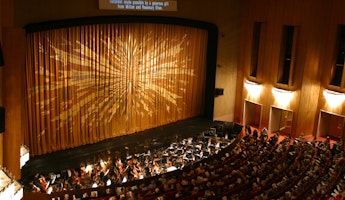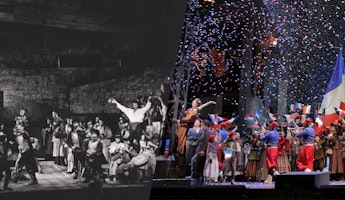Dorothy Chandler Pavilion
135 N Grand Avenue
Los Angeles CA, 90012
LA Opera is located at the Dorothy Chandler Pavilion, part of The Music Center of Los Angeles County.
ABOUT THE THEATRE
The first and largest of the four Music Center venues, the Dorothy Chandler Pavilion was originally called the Memorial Pavilion and was renamed by the LA County Board of Supervisors in honor of Dorothy Buffum Chandler. As one of the largest stages in the United States, it has been the site of unparalleled performances by remarkable music and dance luminaries and virtuosos. It hosted the LA Phil for decades and was the site for the Academy Awards from 1969-1999, and is now home to LA Opera and Glorya Kaufman Presents Dance at The Music Center.
Measuring 330 feet long and 252 feet wide, and featuring 92-foot-high columns that rise from the Jerry Moss Plaza level, the Pavilion’s gracefully curving sides express the functional curve of the auditorium within, while the interior reflects the grandeur of the performances it hosts. Hong Kong-based artisans wove special carpets; the finest acousticians of the time were employed; and two years went into the design and creation of the venue’s three chandeliers.
The theatre lobby is an elegant two-story space that wraps around the east side of the building, featuring honey-toned Mexican onyx and hand-cut Byzantine-style mosaic tile from Venice. The lobby also features paintings and sculptures, including busts of LA Phil conductors Alfred Wallenstein and Otto Klemperer created by Anna Mahler, daughter of composer Gustav Mahler.
On the second floor of the Pavilion is the Eva & Marc Stern Grand Hall, which hosts LA Opera’s ever-popular pre-show talks. Overlooking the Grand Hall are the First and Second Terraces, which provide a spectacular view of three gracefully suspended crystal chandeliers. This floor also features a bronze bust of Mrs. Chandler, sculpted by Los Angeles Times editorial cartoonist and Pulitzer Prize winner Charles Conrad.
On the east side of the Grand Hall is the Oval Lounge, the venue’s main refreshment area, offering an atmosphere of quiet relaxation with walls paneled in black walnut, dark mirrors, and an antique marble bar. The Oval Lounge also features a bust of Giuseppe Verdi honoring the bicentenary of his birth, which was gifted to LA Opera by the Consulate General of Italy-Los Angeles upon the company’s opening of Verdi’s Falstaff in 2013.
The unconventional auditorium design, with a nearly square shape, allows for 90 percent of the audience to be seated within 105 feet of the stage, with the farthest seat located only 130 feet away. The auditorium seats approximately 3,200 guests and is arranged in four levels: Orchestra (1,442 seats), Founders Circle (471 seats), Loge (443 seats) and Balcony (lower with 350 seats and upper with 400 seats). The angle of vision to the stage is never more than 27 degrees down, including the last row of the Balcony’s second tier. Every seat has a completely clear view to the mid-point of the house curtain at the floor line.
The auditorium’s acoustics are favorably impacted by a curved and sloping ceiling, rounded balconies, and walls that lean inward as they rise to the ceiling. A large gold-leaf fiberglass “acoustical cloud” can be moved forward or back and angled according to the needs of each production.
The Pavilion stage is one of the largest and most flexible in the nation. At 60 feet wide, 30 feet high, and up to 240 feet deep, it is as far from the front of the stage to the back of the stage as it is from the front of the stage to the back of the auditorium. The orchestra pit uses a mechanically operated floor in three parts, providing flexibility for any size orchestra and the needs of opera performances. In addition, the floor of the pit can be raised as high as the auditorium floor to increase the stage's size. There are 10 dressing rooms on the stage and mezzanine levels and dressing rooms for 200 dancers and chorus members below the stage. The auditorium comprises only one-third of the entire building, with a music library, rehearsal halls, and staff offices also housed within the Dorothy Chandler Pavilion.








/03-cosi/_dsc0996_pr.jpg?format=auto&fit=crop&w=345&h=200&auto=format)



















